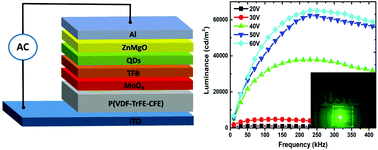Alternating-current driven quantum-dot light-emitting diodes with high brightness†
Abstract
Highly bright alternating-current (AC) driven quantum-dot light-emitting diodes (QLEDs) are demonstrated based on a single dielectric layer structure. The use of a single dielectric layer P(VDF-TrFE-CFE) enables the injection of electrons under AC driving, whereas holes are generated inside the devices by using MoO3/TFB hole generating layers. The brightness of the device is greatly affected by the capacitance of the dielectric layer, the hole generating capability of MoO3/TFB and the driving frequency of the bias. By optimizing the thicknesses of P(VDF-TrFE-CFE) and MoO3 and the driving frequency, an AC-driven QLED with a luminance of 65 760 cd m−2 is demonstrated, which is the highest value ever reported. To improve the efficiency, a tandem AC-driven QLED is further developed, which alternately emits light in the positive and the negative driving cycles. As a result, the tandem AC-driven QLED exhibits a higher luminance and a current efficiency of 50 750 cd m−2 and 5.1 cd A−1, which are 1.3-fold higher than those (39 200 cd m−2, 3.9 cd A−1) of a single AC-driven QLED at the same current density. The demonstrated highly bright QLEDs that are directly driven by AC electricity could therefore eliminate the use of a direct-current (DC) power converter and could provide a potential alternative to conventional DC-driven devices for displays and lighting application.

- This article is part of the themed collection: 2019 Nanoscale HOT Article Collection


 Please wait while we load your content...
Please wait while we load your content...